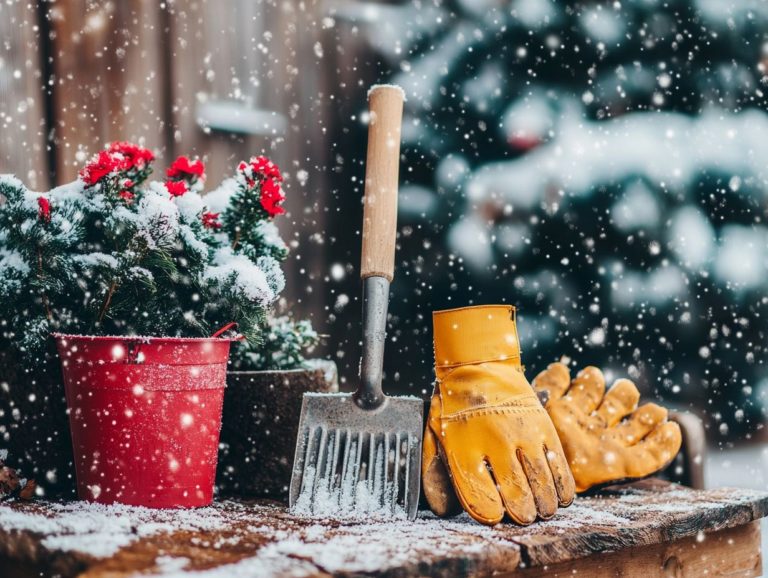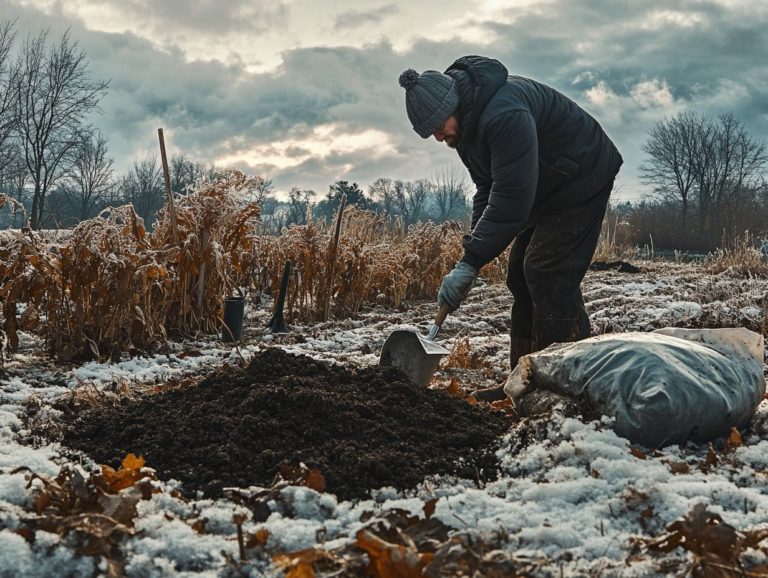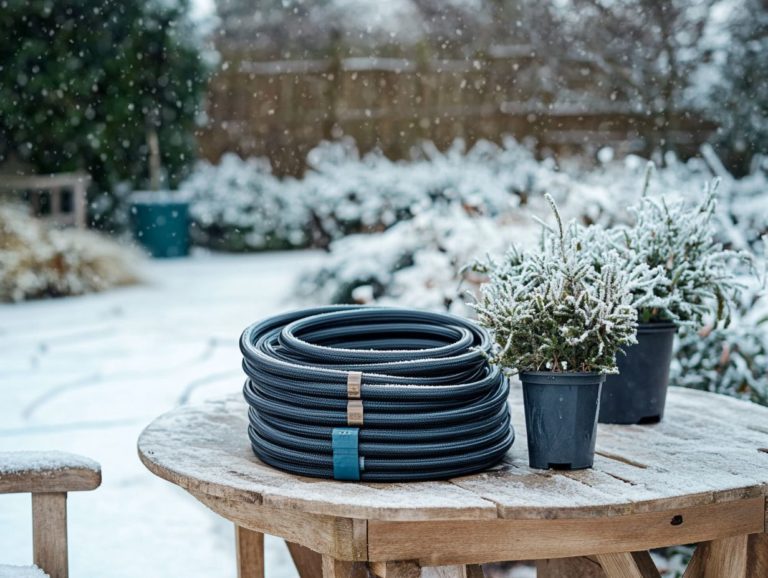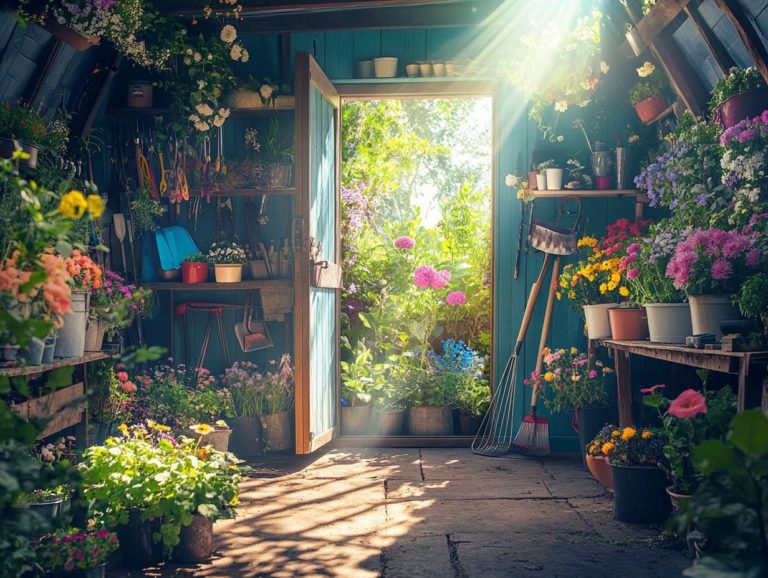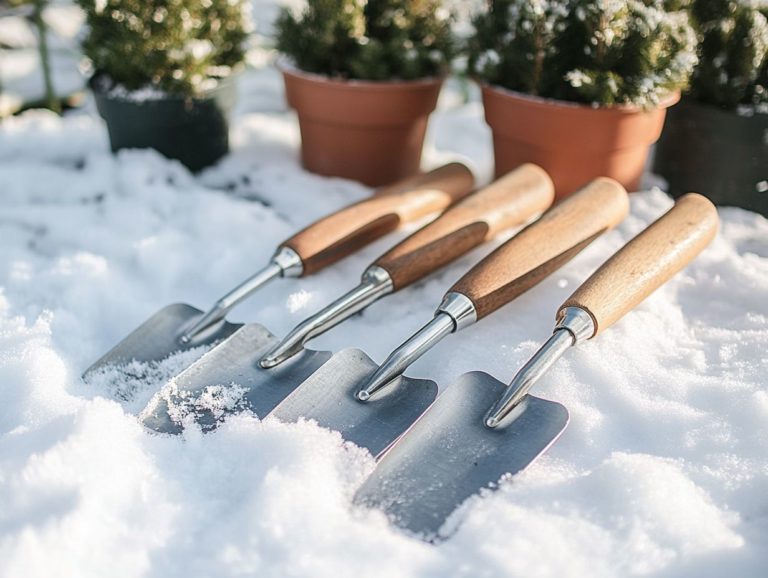How to Use Cold Frames Effectively
Cold frames serve as a gardener’s secret weapon, allowing you to extend your growing season and shield delicate plants from unpredictable weather.
This guide explores the many benefits of using cold frames. You ll learn how to choose the ideal location and master the basics of building and maintaining your own, along with gardening tips for success.
It also highlights which plants thrive best in these cozy environments and offers insights on plant care.
No matter if you re an experienced gardener or just starting out, cold frames can elevate your gardening experience.
Contents
- Key Takeaways:
- Benefits of Using Cold Frames
- Choosing the Right Location for Cold Frames
- Building and Setting Up a Cold Frame
- Using Cold Frames for Different Plants
- Frequently Asked Questions
- What is a cold frame and how do I use it effectively?
- What are the benefits of using cold frames in gardening?
- Can I use cold frames for all types of plants?
- How do I prepare my cold frame for use?
- How often should I water my plants in a cold frame?
- Are there any special maintenance tasks for cold frames?
Key Takeaways:
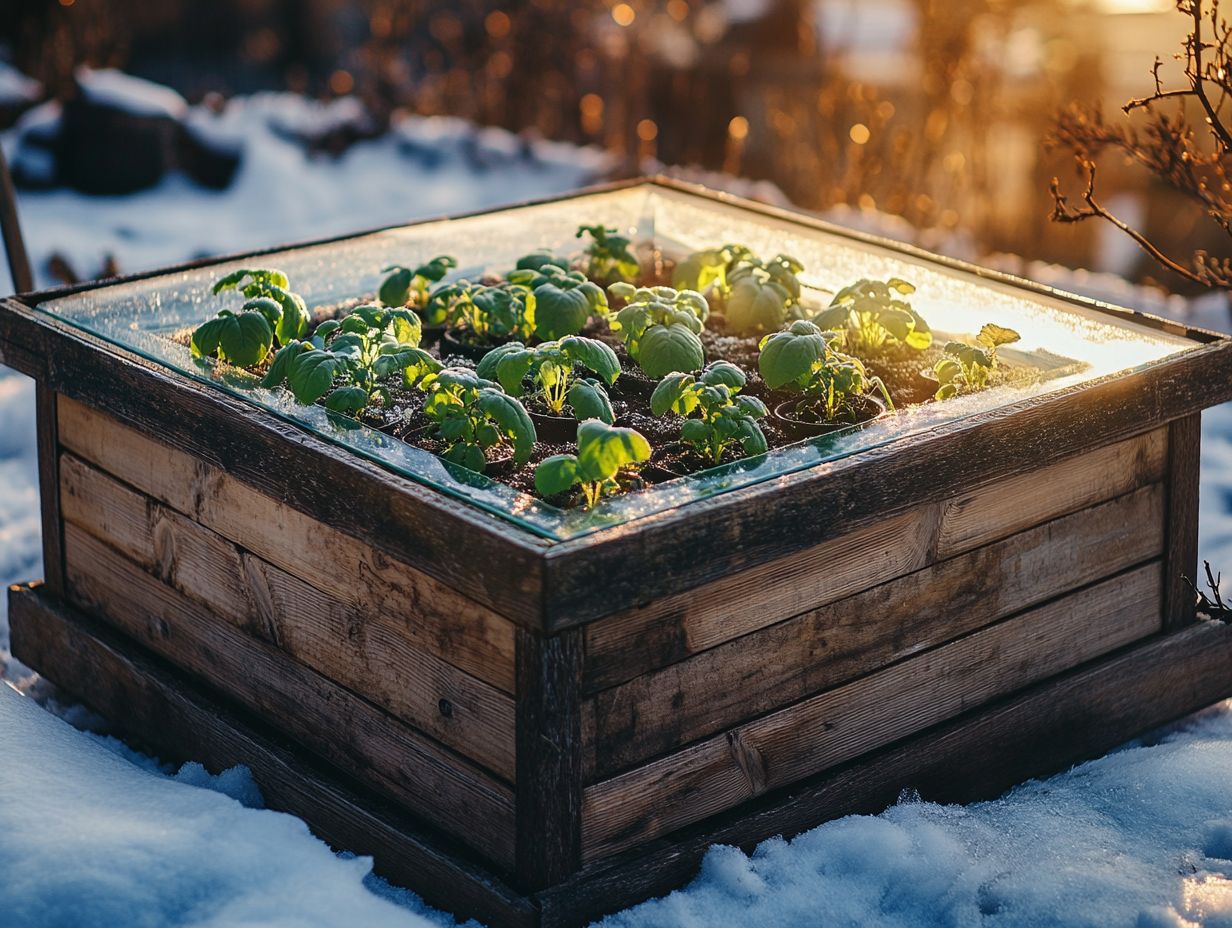
- Extend your growing season by using cold frames.
- Protect your plants from harsh weather conditions with a cold frame.
- Choose the right location, materials, and maintenance for effective use.
What are Cold Frames?
Cold frames are simple structures designed to extend your growing season by creating a warm small climate for your plants. Made from materials like glass or plastic, they can easily be built using wood or straw bales.
These frames protect tender plants, create ideal conditions for starting seeds, and help you monitor temperature changes. This allows you to begin seedlings early and shield them from unfavorable weather.
Cold frames come in various styles, from movable frames that can be easily relocated to permanent installations for specific crops. To maximize their effectiveness, you might also consider learning how to use greenhouses for cold-climate gardening, placing them in a sunny spot and ensuring good ventilation to prevent overheating.
Hardy vegetables like lettuce and spinach flourish in these protected spaces, while other plants can be adjusted gradually in pots.
Covering the frames on chilly nights helps retain warmth, giving you a longer harvest season. It’s also important to monitor soil moisture inside the frame since it can vary significantly from an open garden, ensuring your plants get just the right amount of water without becoming waterlogged.
Benefits of Using Cold Frames
With cold frames, you’ll unlock amazing advantages that transform your gardening! They allow you to extend your growing season and protect delicate plants from harsh weather.
These structures create a small climate that promotes seedling growth by providing warmth, moisture control, and protection against temperature swings.
By effectively using cold frames for winter gardening, you can maximize your yields year-round while applying strategic planting techniques that enhance your gardening success.
Extend Growing Season
Cold frames are a fantastic way to prolong the growing season for various plants. They enable you to start seedlings earlier in spring and continue harvesting into fall. Utilizing these structures helps maintain consistent soil moisture and reduce temperature fluctuations, creating an ideal growth environment.
This not only aids in starting seeds but also boosts the overall health of your plants, ensuring they receive the warmth they need.
For example, cold frames significantly benefit brassicas a family of vegetables including kale and broccoli that thrive in cooler temperatures yet appreciate additional warmth during germination. Placing young seedlings in a cold frame can help them withstand late frosts, allowing for an earlier harvest.
Perennials also thrive in cold frames, as they can develop strong root systems before harsher weather arrives. A practical tip is to check the internal temperature with a thermometer and open the lid during warmer parts of the day to prevent overheating.
Regularly check soil moisture to ensure plants remain hydrated without becoming waterlogged. This promotes optimal growth throughout the extended season and enhances your plant care.
Start building your cold frame today to boost your gardening success!
Protect Plants from Harsh Weather
Cold frames create a protective haven for your tender plants. They shield them from frost, wind, and excessive rainfall.
By carefully monitoring the temperature within these frames, you can cultivate an environment where your crops not only survive but truly flourish. This level of protection is especially vital in vegetable gardening, where young seedlings are often at risk.
Cold frames also help reduce other unfavorable conditions like intense sun exposure and sudden temperature swings. According to the Royal Horticultural Society, using cold frames can extend your growing season by several weeks—a game-changer for anyone eager to maximize their yield. Additionally, learning how to use row covers effectively can further enhance your gardening success.
It’s important to ensure proper ventilation to maintain good air circulation and avoid overheating. Research indicates that without adequate ventilation, temperatures can spike too quickly, putting your plants’ health and growth at risk.
Thus, striking the right balance between insulation and airflow in cold frames is essential for your gardening success.
Choosing the Right Location for Cold Frames
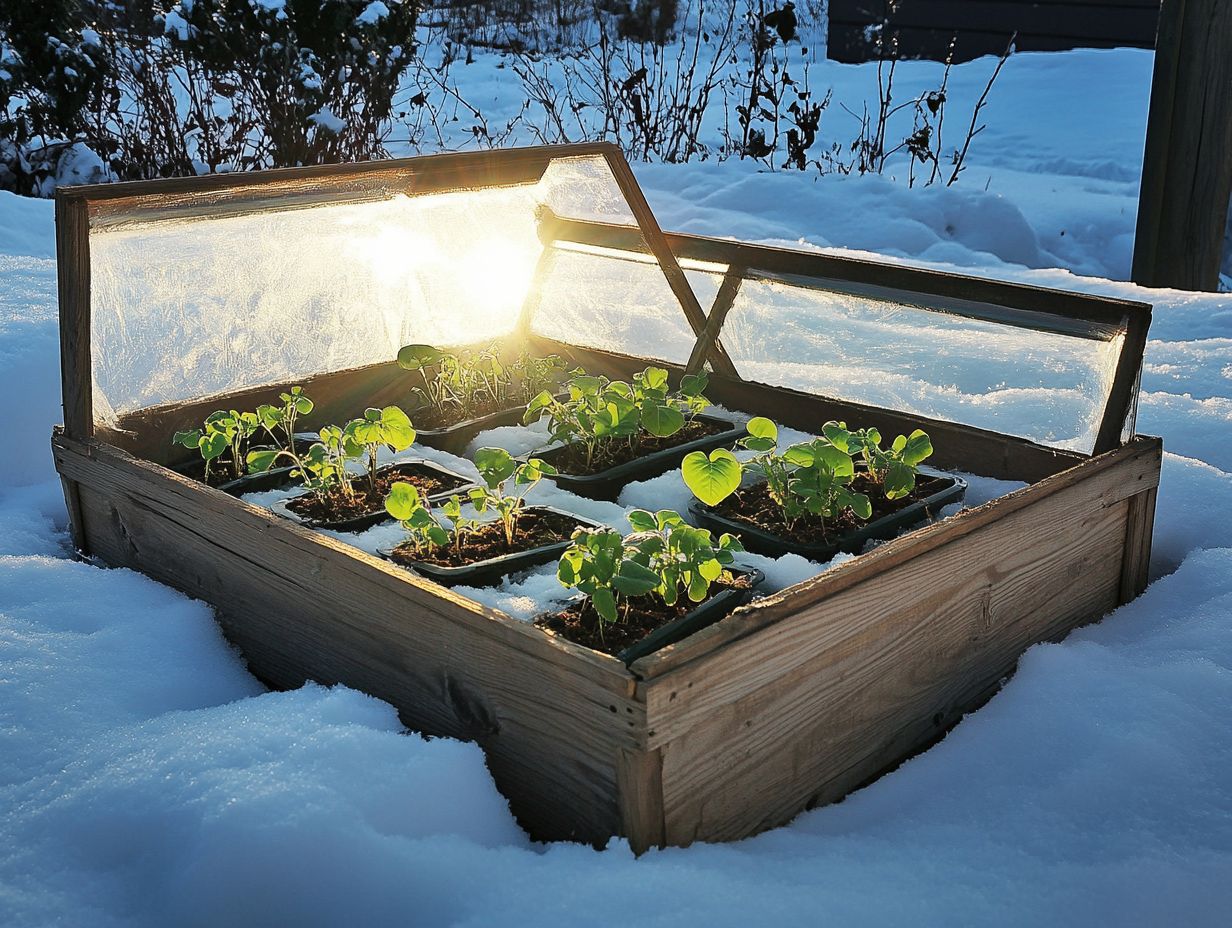
Selecting the perfect location for your cold frames is crucial to maximizing their effectiveness. Look for a spot that basks in abundant sunlight while also offering shelter from harsh winds.
Don t overlook factors like how close it is to your gardening area and the quality of the soil. Easy access to monitor temperature and soil moisture will elevate your gardening experience and help your plants flourish.
Factors to Consider
When you’re setting up cold frames, several critical factors demand your attention. Sunlight exposure is paramount; without sufficient light, your plants simply won’t thrive.
Additionally, wind protection is essential to shield your tender seedlings from harsh elements. The type of soil you choose and its ability to hold water greatly influences the health of the plants nestled within each frame.
Choosing the right placement for your cold frames can dramatically enhance their performance. Positioning them with a south or southwest orientation allows you to maximize sun exposure, particularly crucial during those chilly months.
Keep in mind the local climate variations. In areas with consistent moisture, you may find you need to water less frequently, while drier regions might require a bit more irrigation.
According to guidelines from the University of Minnesota, understanding these environmental factors helps you optimize temperature fluctuations and boosts overall plant health. This means you can look forward to a more fruitful growing season.
Building and Setting Up a Cold Frame
Building and setting up a DIY cold frame is a truly rewarding endeavor. It allows you to utilize readily available raw materials to create an effective growing environment for your plants.
These structures can be crafted from a variety of materials, such as glass, plastic, and wood. This gives you the freedom to customize the design according to your resources and specific needs.
Ensuring proper construction and maintenance is essential for achieving long-term success and functionality. This will transform your gardening experience into something extraordinary.
Ready to protect your plants? Start building your cold frame today!
Materials and Construction
The materials you choose for constructing cold frames are pivotal to their effectiveness and longevity. Select the right components for your DIY project!
Common options like glass, plastic, and straw bales offer ease of construction and sufficient insulation. By understanding the benefits of each material, you can craft a cold frame that fits your gardening needs and local climate.
Evaluating the pros and cons of these materials is crucial. While glass provides great visibility and heat retention, it can be pricier and requires careful handling. In contrast, plastic sheeting is budget-friendly and lightweight, but it may not offer the same insulation over time. Straw bales have natural insulation and low cost, but they need thoughtful placement and maintenance.
Using clear building methods, such as frame designs and anchoring methods ideally shown with diagrams can greatly enhance your ability to build a sturdy and functional cold frame. This will create a better small climate for your plants.
Proper Placement and Maintenance
Proper placement and maintenance of your cold frames are essential! Position your frame where it gets ample sunlight and is shielded from excessive wind to help mitigate temperature fluctuations.
Regular maintenance is key. Vent your frame to prevent overheating and maintain a healthy small climate within!
To manage temperature and humidity, check conditions regularly with a thermometer and a tool that measures humidity, ensuring they stay within ideal ranges for your plants. During warmer months, prop the lid open on hot days to let excess heat escape.
Seasonal maintenance is also important. Cleaning the glass or plastic panels boosts light penetration. Regularly checking for pests and diseases helps with early detection, enhancing crop productivity and ensuring great harvests!
Using Cold Frames for Different Plants
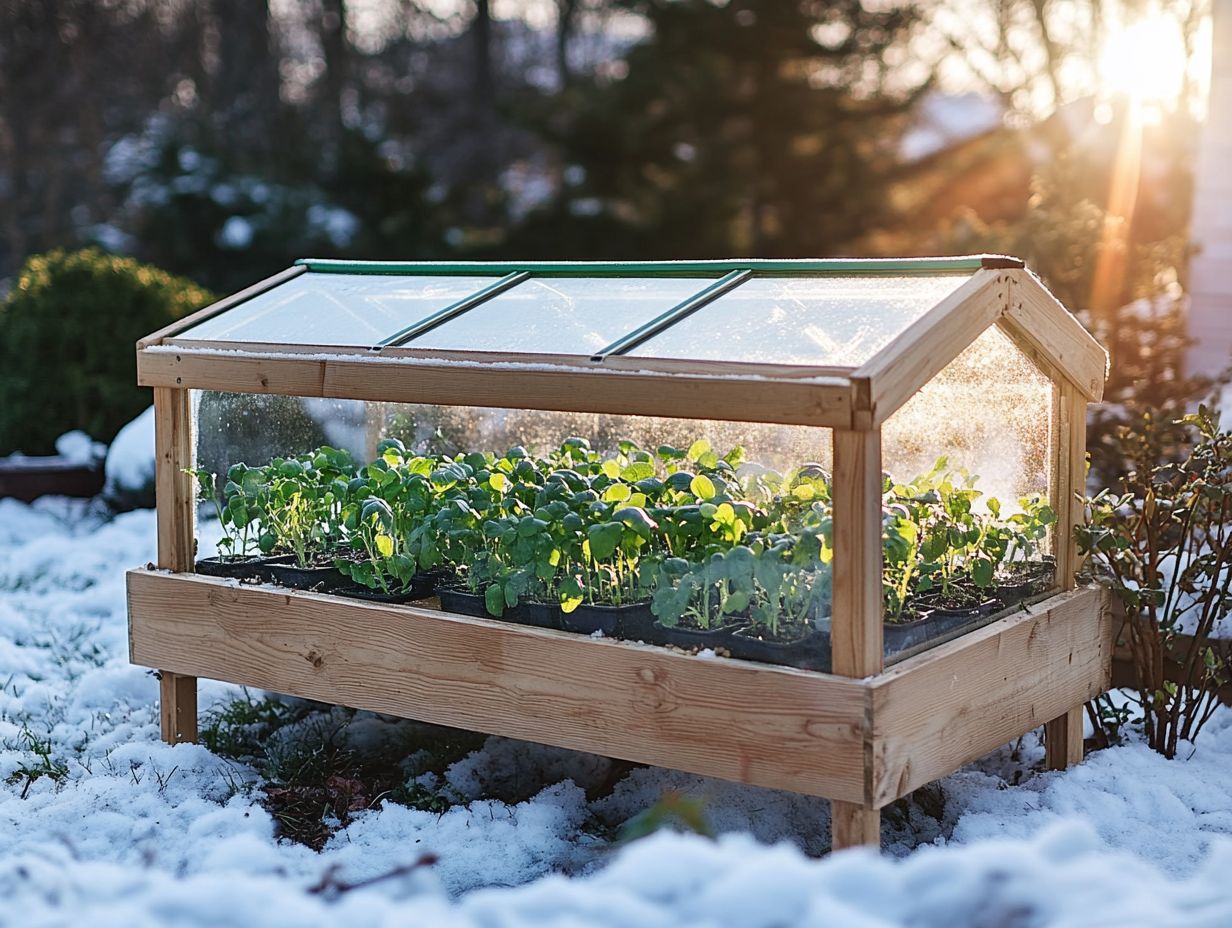
Cold frames are an exceptional tool, allowing a diverse range of plants to flourish and elevating your gardening experience.
Whether you re nurturing vegetable seedlings or cultivating robust brassicas, these structures create the perfect environment for various growth stages.
By understanding the specific care requirements for different plants within a cold frame, you can significantly enhance both yield and overall plant health.
Best Plants for Cold Frames
The best plants for your cold frames include a delightful assortment of seedlings, vegetables, and some perennials. Early greens, brassicas, and delicate herbs are popular choices that thrive in the warmth and protection provided.
Varieties like spinach, lettuce, and kale are excellent candidates for cold frames. They germinate quickly in cooler temperatures while soaking up the necessary light. Keep the soil moist and watch for any pests that might be drawn to this cozy habitat.
For optimal results, sow your seeds in early spring about four to six weeks before the last expected frost.
As your seedlings mature, don t forget to gradually get them used to outdoor conditions. This process, known as hardening off, ensures a smooth transition and sets you up for a resilient garden this season!
Caring for Plants in Cold Frames
Caring for plants in cold frames demands your diligent attention to soil moisture and temperature to create optimal growth conditions. Monitoring these factors is essential, as even minor fluctuations can affect the health and development of your seedlings.
By adhering to best practices in plant care, you can cultivate a thriving environment that enhances growth and maximizes yields. Establish a regular watering schedule by checking soil moisture levels at least once a week, or more frequently during warmer days.
Aim for the soil to remain consistently moist but not waterlogged, as too much water can cause root rot, a condition that can harm plant roots.
Keep a close eye on the temperature, ideally maintaining it between 65 F and 75 F. This range is crucial for encouraging seed germination and sturdy growth. Using thermometers or digital monitors can help track daily fluctuations.
Proper ventilation is important. On sunny days, slightly opening the cold frame helps prevent overheating, ensuring a balanced environment that supports healthy plants.
Regularly rotating your plants and incorporating compost will enhance soil richness, leading to more robust growth. Follow these tips, and watch your plants thrive like never before!
Frequently Asked Questions
What is a cold frame and how do I use it effectively?
A cold frame is a gardening tool used to extend the growing season for plants. It is a simple structure made of clear materials, such as glass or plastic, that traps heat and creates a warmer environment for plants. To use it effectively, place it in a sunny location and monitor the temperature inside to ensure it is not too hot or cold for your plants.
What are the benefits of using cold frames in gardening?
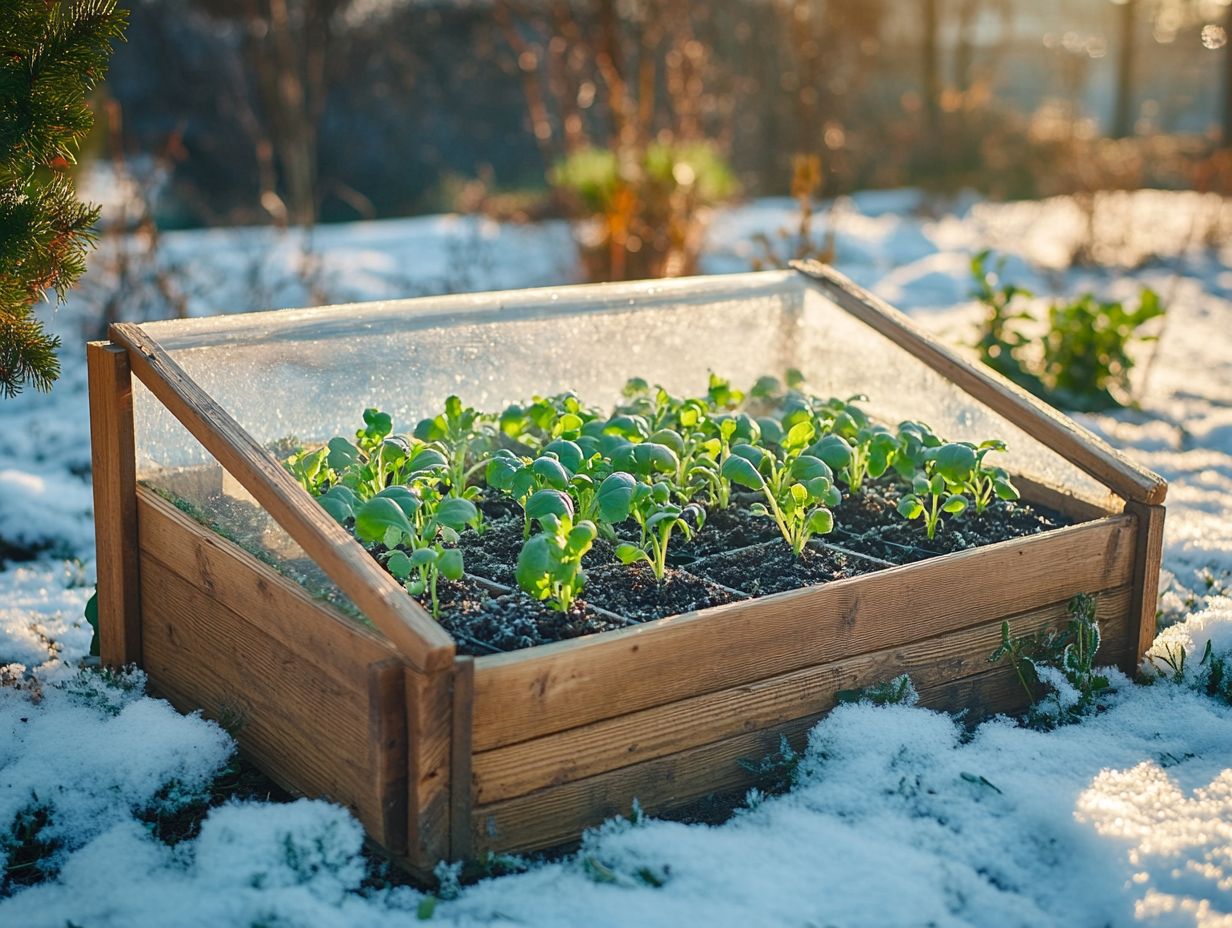
Cold frames offer several benefits, including extending the growing season, protecting plants from frost and harsh weather, and creating a microclimate for heat-loving plants. They are also a cost-effective and eco-friendly way to grow plants.
Can I use cold frames for all types of plants?
Yes, cold frames can be used for a variety of plants, including vegetables, herbs, flowers, and seedlings. However, it is important to research the specific needs of your plants to ensure they will thrive in a cold frame environment.
How do I prepare my cold frame for use?
Before using your cold frame, clean the interior and exterior of any debris or dirt. Add a layer of organic matter, such as compost or aged manure, to the bottom to provide nutrients for your plants. Finally, fill the frame with soil and water thoroughly before planting.
How often should I water my plants in a cold frame?
The frequency of watering will depend on the type of plants you are growing and the weather conditions. Cold frames tend to retain moisture, so you may not need to water as often as you would for plants in an open garden. Monitor the soil moisture and water when needed.
Are there any special maintenance tasks for cold frames?
Regularly monitor the temperature inside the cold frame and adjust ventilation accordingly. Remove any dead plants or weeds to prevent pests and diseases. Clean the interior and exterior of the frame regularly to prevent the buildup of debris.
Start your gardening journey with a cold frame and enjoy extended harvests!

